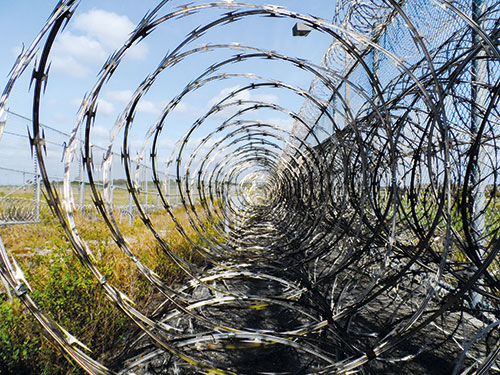

The ever-rising cost of living in South Africa has everyone, rich or poor, young or old, worried about their future. The looming economic collapse of our nation as a whole makes long-term planning risky and thus, home and business owners as well as estate managers are concentrating on short- to medium-term planning instead.
This plays a significant role in the budgeting for, and purchasing of, capital expenditure items such as complete, all-encompassing security systems for homes, businesses or estates.
Over the last few years we have seen significant changes in the law regarding estate and sectional title management, with the advent of the Sectional Title Ombudsman’s office, which needs to be jointly funded out of the levy contribution of each levy payer; and the legal enforcement of a maintenance, repair and replacement plan (which, in itself, is a fundamentally sound decision), which has meant that funds usually earmarked for capital expenditure now need to be stockpiled in order to comply with the timelines set out in the act.

What does this mean in terms of security?
Most walled estates use the fact that they have high walls and access control, as a ‘security estate’ selling point, however, when being assessed by an experienced threat, risk and vulnerability assessor, they fall well short in terms of adequate protection against all vulnerabilities.
Unplanned estate security has become a copycat exercise; “Estate A has the same type of houses and similar class of residents as we do, so let’s just emulate their security features to ensure sales in our estate”. However, there are any number of factors which make Estate A different, in terms of criminal vulnerability, to Estate B and thus the copycat security protocol is totally ineffective.
Differences such as location in terms of proximity to informal settlements, open field areas, highways, access and egress roadways and varied socio-economic neighbourhoods, all play a huge role in determining risk and resultant vulnerability to estates and their residents.
This is why it is vitally important to begin with a security threat, risk and vulnerability assessment! Not a site visit or survey by an installation or guarding company, but a properly constituted, independent assessment by an assessor who is not going to quote you on any of the products suggested.
What does this mean? An installer or guarding company will look at your premises with the intent of selling you a product, whereas the independent assessor will report on your risk, give you a report advising where the vulnerabilities are, their priorities, and how to mitigate them.
The effectiveness of any estate security installation plan is directly related to the credibility and thoroughness of the assessment conducted before any solutions or installations are contemplated.
This allows the client to make the decision as to what, out of the suggested recommendations, they can afford according to the estate’s budget, and will give the estate bargaining power, as the management of the estate will be armed with a thorough security plan, preventing installers from over-selling.
The importance of independent assessments
The importance of conducting the threat, risk and vulnerability assessment cannot be overstated. Ultimately, the security design and process suggestions have to be aligned to the security purpose, based on the nature of the threats and the estates vulnerabilities highlighted in the assessment report. Invariably, the suggested actions which are put in place by the estate will reduce the vulnerabilities and weaknesses significantly.
Thus, if your budget is tight and you think that you are saving money by forgoing an assessment, and just installing what you observed at Estate A, you are not only going to waste your money on ineffective electronics, but you also put your residents at risk, as you did not know about, or mitigate, your estate’s vital vulnerabilities.

One of the greatest advantages of a thorough assessment report is that it creates the platform for effective security budget planning. With this in mind, it is vital that the estate budget committee does not see that security budget as pure expenditure; it needs to be seen as an investment with long-term positive results as nothing kills an estate’s reputation quite like criminality occurring within its walls.
A very applicable quote from Tony Botes (administrator of the Security Association of South Africa) always comes to mind when I talk to estates regarding their security budget; it states: “If you cannot afford the cost of professional and high quality security, please consider the ultimate cost of cheap and ineffective security.”
A second, yet very applicable quote, also from Tony Botes, states: “It is not possible to expect a professional security service if you expect it to be provided at sub-standard rates.”
Effective security budgeting
With this in mind, I advise estates to prioritise their services contained within the levies they manage; would you rather be safe and secure than have great gardens you cannot enjoy if you are dead. Get the residents to do their own gardens; but keep them safe. Would you rather have a sparkling swimming pool, tennis court and gym, or would you prefer not to be mugged on your way to these facilities from your house? These facilities are all nice-to-have add-ons which the residents themselves can, if needed, maintain through community projects.
Security needs to be the second budget item on an estate’s budget, slotting in directly after municipal rates and taxes – it’s that important. There are estates whose gardening budget far supersedes their security budget and, thus, the only conclusion to be made here is that their priority is aesthetics rather than the safety and security of their residents.
Given the state of crime in South Africa at present, we need to take into consideration that the paradigm of security and threats to human survival have changed significantly. Murder and armed robbery have become so commonplace that we are no longer shocked or appalled by them, unless they occur on our doorstep or happen to someone close to us. Thus, the best security measure in any estate’s arsenal is to create an awareness of the vulnerabilities that occur within and immediately outside the estate and to nurture a security mindset in each of the estate’s residents.
In terms of budgetary restraint after the assessment has been completed, it is not always financially possible to comply with all of the recommended procedures and, thus, the estate management needs to sit down and prioritise what needs to be done first with the limited funds available. Here are a few guidelines:
Guideline 1: Create a security baseline before adding expensive equipment
They say that strong walls make great neighbours, thus, if the estate has a strong perimeter wall or fence, it will go a long way towards deterring criminals.
Until the estate can afford to install an electrified fence, it will make life difficult for criminals attempting to scale the wall if you prevent access to the outer wall itself, by laying a two-metre path of quarry stone or by planting thorny shrubs such as Whale-tongue Agave. Some estates combine the two.
Perimeter lighting will also make life more difficult for a criminal to scale the wall, as he faces the risk of exposure. Trees and large shrubs (other than those thorny shrubs protecting the wall) should be kept trimmed in order to prevent criminals from hiding there. The way to trim a shrub is from the top down and from the bottom up. This way, it is not high enough to hide behind and his legs will be visible from below.
A strong perimeter wall will, by implication, make the estate gates into the preferred unauthorised entry point, therefore, attention needs to be given to effective access and egress. This can, in fact, be achieved by motorising the gate and educating residents using the gate on effective gate security.
In terms of the gate, it would be advisable to rather have a see-through gate in lieu of a solid gate; this way, residents inside can look to see if it is safe to open the gate before opening it. Residents should be taught that they should not open the gate if they are approaching the gate from outside and they notice loiterers or any car seemingly following them. They should rather stop away from the gate and allow the following car to pass. They should not turn into the driveway to the gate to allow someone to pass, but rather on the road (this makes hijacking and tailgating more difficult).
Residents also need to be taught to observe the gate and wait for it to close properly before driving into or out of the gate.
If the estate has multiple gates, it may be safer to only have one gate. Yes, it may be frustrating to residents, but it will save money on manpower and equipment, until a future budgeting cycle allows funds for the second gate.
Make security part of each resident’s responsibility; this way the financial burden is less on the communal levy and more on the owner’s personal account. Create an amendment in the estate rules that makes security each owner's/tenant’s responsibility.
Educate residents that guards and electronic security measures are merely add-ons and that the actual security system within the estate is the residents themselves. Encourage each household to secure their own premises with individual home alarms, home CCTV camera systems (which also cover sections of the street outside their home), motor gates, security gates and burglar bars/shutter-guards, etc.
Encourage residents to ensure that they are not easy targets to criminals by locking their doors, garages and sheds. Create resident security groups on platforms such as WhatsApp.
Create a secure whistle-blowing platform for security alerts, should neighbours notice adverse behaviour which could result in security threats. All residents should ensure that they have adequate lighting around their homes and that trees and shrubs do not provide ideal hiding spots for criminals.
Institute resident patrols inside and outside the estate, where residents can take it in turns to patrol the inner and outer perimeter of the estate. When criminals observe the estate with the intent to break in, they may choose to go somewhere else if they see that the risk of being exposed is higher or even undetermined.
Within the estate, one can utilise the salaried gardeners to trim back trees, shrubs and bushes, thus eliminating places where criminals can hide; the added advantage to this is that the gardening budget is then, by implication, being used for security purposes, without the possibility of dispute from the Department of Labour or the Compensation Commissioner.
Nothing exposes crime or criminals quite as well as illumination. As already mentioned, the management committee should encourage residents to ensure their own lighting on their individual properties; added to this, adequate perimeter, road and walkway lighting and you have a very effective (although not totally fool-proof) crime fighting tool.
Guideline 2: Enhance the security baseline with prioritised add-ons
When presented with a threat, risk and vulnerability report by an experienced assessor, one would generally find a list of recommendations coupled to a properly formatted assessment which outlines the suggested priorities. Bodies Corporate and Home Owners’ Associations should, where possible, attempt to follow these recommendations as far as possible.
As previously stated, the estate perimeter is the most important security tool in your arsenal and enhancing the perimeter and gate security to optimal will always be the advice of any legitimate assessor.
On a tight budget, it may be necessary to repair, replace or install new equipment – in that order. If equipment can be repaired, such as rewiring an electric fence, or having a camera serviced, or even replacing an existing RF reader, it could prove to be cost-effective in the short to medium term; however, remember to plan for a replacement cycle as soon as possible, in order to prevent outdating.
Should the estate not have electronic security elements in place, it needs to be kept in mind that the purchase and installation of equipment is generally expensive, thus, such expenditure will need to be registered and budgeted for as a capital expense or registered as a special project. This is also where the assessor’s input on priority becomes very important.
Guideline 3: Always buy the best equipment you can afford
So often, estates have a look at the grand total at the bottom of a quote and, due to the high price, coupled with their disbelief that they could convince their Home Owners’ Association or Body Corporate that it is a necessary expense, they rather cancel the whole project.
This is completely unnecessary, as there are bodies that provide project loans to Bodies Corporate and Home Owners’ Associations, but one could also break up the project into bite-size phases. Once the wired/fibre backbone is laid, and the initial head-end equipment is in place, one can add onto this backbone as one’s budget allows.
Even electrified fencing can be done in phases, and any legitimate assessor would have highlighted the perimeter vulnerabilities in the report, thus, one can start with the section of the perimeter with the greatest vulnerability and, as the budget allows, follow on with the rest.
By doing these projects in phases, one can then afford to install better equipment which, in the long run, provides better service.
Estate management should keep in mind that, although many of the world’s top security products are produced in China, these are distributed locally through legitimate distributors, who have the necessary ability to honour guarantees and warranties; this is because the equipment they sell is of a high and reliable quality. Purchasing cheap technology from the Asian or sub-continental markets is risky and will end up in frustration in the long run as the guarantee expires when you walk out of their shop.
My personal phrase to prospective clients who say to me “I can get this a lot cheaper at the Asian market” is, “if you buy your products from the Asian market, make sure that you get an Asian to install it, as I cannot guarantee excellent output from sub-standard equipment.”
In conclusion
Every individual, no matter where you are in the world, has the right to safety. Along with this, is the right to protect him/herself effectively from harm, by any means, as long as those actions used may be justifiable and excusable by law. This is all very well and good, but what needs to be taken into consideration in South Africa today is that the average criminal does not care how much destruction he causes in order to get what he wants, thus, even your life is considered worthless against the value of your car, cash, jewelry or cellphone.
The incidence of residential break-ins, with and without resultant violent assault, has grown to mammoth proportions in our nation and the police force cannot possibly cope with the influx. Thus, it is up to the individual to maintain a constant state of preparedness.
The propensity of many, in an attempt to ensure their family’s security, has been to purchase property within walled and security controlled complexes. However, this has also proven to be somewhat risky as criminal syndicates can often afford to purchase property within these complexes and they literally prey on their complacent neighbours. This is the reason as to why each residential estate should invest in a security risk assessment.
The security risk assessment helps to identify those areas in your estate that are vulnerable to breach and should therefore be protected. The assessment also assists in the determination of which security controls need to be used and the type of security system that will best suit your needs.
Not all persons in South Africa can afford complex security equipment; however, by doing a complete security risk assessment and following a logical chain of thought, anyone can have a degree of protection.
Sentinel Risk Management has been in the threat, risk and vulnerability assessment business for 13 years, before which, the owner of the company and author of this article, Andy Lawler, spent 27 years in the National Defence Force. Sentinel’s clients range from Japan to Europe and Canada, as well as across Africa to locally based businesses, estates, government and parastatal entities within South Africa, including prominent hospital groups and high-end residential estates.
If you would like to do a legitimate, thorough residential threat, risk and vulnerability assessment at your estate, before or after you have installed security equipment, please contact Andy Lawler on

© Technews Publishing (Pty) Ltd. | All Rights Reserved.